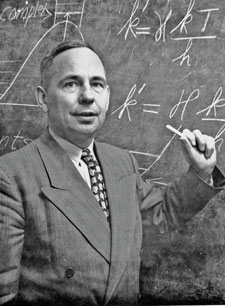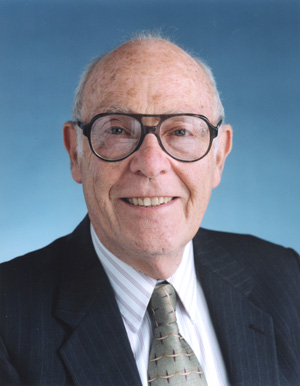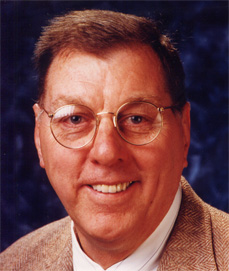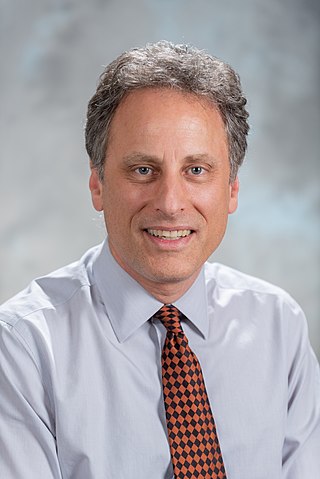Related Research Articles

Henry Eyring was a Mexico-born United States theoretical chemist whose primary contribution was in the study of chemical reaction rates and intermediates. Eyring developed the Absolute Rate Theory or Transition state theory of chemical reactions, connecting the fields of chemistry and physics through atomic theory, quantum theory, and statistical mechanics.

John Werner Cahn was an American scientist and recipient of the 1998 National Medal of Science. Born in Cologne, Weimar Germany, he was a professor in the department of metallurgy at the Massachusetts Institute of Technology (MIT) from 1964 to 1978. From 1977, he held a position at the National Institute of Standards and Technology. Cahn had a profound influence on the course of materials research during his career. One of the foremost authorities on thermodynamics, Cahn applied the basic laws of thermodynamics to describe and predict a wide range of physical phenomena.
Jürgen Gmehling is a retired German professor of technical and industrial chemistry at the Carl von Ossietzky University of Oldenburg.

In statistical thermodynamics, the UNIFAC method is a semi-empirical system for the prediction of non-electrolyte activity in non-ideal mixtures. UNIFAC uses the functional groups present on the molecules that make up the liquid mixture to calculate activity coefficients. By using interactions for each of the functional groups present on the molecules, as well as some binary interaction coefficients, the activity of each of the solutions can be calculated. This information can be used to obtain information on liquid equilibria, which is useful in many thermodynamic calculations, such as chemical reactor design, and distillation calculations.

The non-random two-liquid model is an activity coefficient model introduced by Renon and Prausnitz in 1968 that correlates the activity coefficients of a compound with its mole fractions in the liquid phase concerned. It is frequently applied in the field of chemical engineering to calculate phase equilibria. The concept of NRTL is based on the hypothesis of Wilson, who stated that the local concentration around a molecule in most mixtures is different from the bulk concentration. This difference is due to a difference between the interaction energy of the central molecule with the molecules of its own kind and that with the molecules of the other kind . The energy difference also introduces a non-randomness at the local molecular level. The NRTL model belongs to the so-called local-composition models. Other models of this type are the Wilson model, the UNIQUAC model, and the group contribution model UNIFAC. These local-composition models are not thermodynamically consistent for a one-fluid model for a real mixture due to the assumption that the local composition around molecule i is independent of the local composition around molecule j. This assumption is not true, as was shown by Flemr in 1976. However, they are consistent if a hypothetical two-liquid model is used. Models, which have consistency between bulk and the local molecular concentrations around different types of molecules are COSMO-RS, and COSMOSPACE.

Leo Brewer was an American physical chemist. Considered to be the founder of modern high-temperature chemistry, Brewer received his BS from the California Institute of Technology in 1940 and his PhD from the University of California, Berkeley, in 1942. Brewer joined the Manhattan Project following his graduate work, and joined the faculty at the University of California, Berkeley in 1946. Leo Brewer married Rose Strugo in 1945. They had three children, Beth Gaydos, Roger Brewer, and Gail Brewer. He died in 2005 as a result of Beryllium poisoning from his work in World War II.

In statistical thermodynamics, UNIQUAC is an activity coefficient model used in description of phase equilibria. The model is a so-called lattice model and has been derived from a first order approximation of interacting molecule surfaces. The model is, however, not fully thermodynamically consistent due to its two-liquid mixture approach. In this approach the local concentration around one central molecule is assumed to be independent from the local composition around another type of molecule.

Annual Review of Chemical and Biomolecular Engineering is an annual peer-reviewed scientific journal published by Annual Reviews, covering chemical and biomolecular engineering. The co-editors are Michael F. Doherty and Rachel A. Segalman. As of 2023, Journal Citation Reports, gives the journal an impact factor of 8.4.
Grant McDonald Wilson was a notable American thermodynamicist. He is widely known to the fields of chemical engineering and physical chemistry for having developed the Wilson equation, one of the first attempts of practical importance to model nonideal behavior in liquid mixtures as observed in practice with common polar compounds such as alcohols, amines, etc. The equation has been in use in all commercial chemical process simulators to predict phase behavior and produce safe process designs of commercial and environmental protection importance to the chemical industry. He founded the company Wilco in 1977 to research, measure, commercialize, and publish thermophysical property data for numerous chemical mixtures of interest to the industry. The Journal of Chemical & Engineering Data published a posthumous issue in honor of Wilson in April 2014 in recognition of his extensive contributions to the field.

John A. Quinn was the Robert D. Bent Professor Emeritus of Chemical and Biomolecular Engineering at the University of Pennsylvania School of Engineering and Applied Science. He was a leader in the fields of mass transfer and membrane transport in synthetic membranes since the 1960s. In the early phase of his career at the University of Illinois, Quinn and his students devised simple, elegant experiments to elucidate the role of the interface in mass transfer between phases. In later work at Penn, he applied these insights to problems of engineering and biological significance involving chemical reaction and diffusion within and through both finely porous and reactive membranes. His chemical engineering science has informed matters as far afield as the separation of chiral pharmaceuticals and the behavior of cells at interfaces.
COSMO-RS is a quantum chemistry based equilibrium thermodynamics method with the purpose of predicting chemical potentials μ in liquids. It processes the screening charge density σ on the surface of molecules to calculate the chemical potential μ of each species in solution. Perhaps in dilute solution a constant potential must be considered. As an initial step a quantum chemical COSMO calculation for all molecules is performed and the results are stored in a database. In a separate step COSMO-RS uses the stored COSMO results to calculate the chemical potential of the molecules in a liquid solvent or mixture. The resulting chemical potentials are the basis for other thermodynamic equilibrium properties such as activity coefficients, solubility, partition coefficients, vapor pressure and free energy of solvation. The method was developed to provide a general prediction method with no need for system specific adjustment.
Norman F. Carnahan is an American chemical engineer, a Fellow of The American Institute of Chemical Engineers. He is the Founding Chair of the Upstream Engineering and Flow Assurance (UE&FA) Forum of AIChE. From 2011 - 2019, he served as the AIChE member on the Board of Directors of The Offshore Technology Conference.
İlhan Arif Aksay is American materials scientist. He is the Pomeroy and Betty Perry Smith Professor in Engineering and Emeritus Professor of Chemical and Biological Engineering within the School of Engineering and Applied Science at Princeton University, Princeton, New Jersey, United States
Athanassios Z. Panagiotopoulos is currently the Susan Dod Brown Professor and Department Chair of the Department of Chemical and Biological Engineering of Princeton University.
Teresa Lyn Head-Gordon is an American chemist and the Chancellor's Professor of Chemistry, Bioengineering, and Chemical and Biomolecular Engineering at the University of California, Berkeley. She is also a faculty scientist in the Chemical Sciences Division at the Lawrence Berkeley National Laboratory and a fellow of both the American Institute for Medical and Biological Engineering and the American Chemical Society (ACS).

William Michael Gelbart is Distinguished Professor of Chemistry and Biochemistry at the University of California, Los Angeles, and a member of the California NanoSystems Institute and the UCLA Molecular Biology Institute. He obtained his Bachelor of Science degree from Harvard University in 1967, his Master's (1968) and PhD (1970) degrees from the University of Chicago, and did postdoctoral work at the University of Paris (1971) and the University of California, Berkeley (1972). After 30 years of research in theoretical physical chemistry, contributing notably to the fields of gas-phase photophysics, optical properties of simple liquids, and the statistical physics of complex fluids, he started a biophysics laboratory with Charles Knobler in 2002 to investigate the physical aspects of viral infectivity.
Joan F. Brennecke is an American chemical engineer who is the Cockrell Family Chair in Engineering in the McKetta Department of Chemical Engineering at the University of Texas at Austin. Brennecke develops supercritical fluids, ionic liquids and novel spectroscopic methods.
Pablo G. Debenedetti is the Class of 1950 Professor in Engineering and Applied Science and a professor of chemical and biological engineering at Princeton University. He served as Princeton's Dean for Research from 2013 to 2023. His research focuses on thermodynamics, statistical mechanics, and computer simulations of liquids and glasses.

Mark Robert Prausnitz is an American chemical engineer, currently Regents’ Professor and J. Erskine Love, Jr. Chair in Chemical & Biomolecular Engineering at the Georgia Institute of Technology. He also serves as adjunct professor of biomedical engineering at Emory University and Adjunct Professor of Chemical & Biomolecular Engineering at the Korea Advanced Institute of Science and Technology. He is known for pioneering microneedle technology for minimally invasive drug and vaccine administration, which has found applications in transdermal, ocular, oral, and sustained release delivery systems.
Statistical associating fluid theory (SAFT) is a chemical theory, based on perturbation theory, that uses statistical thermodynamics to explain how complex fluids and fluid mixtures form associations through hydrogen bonds. Widely used in industry and academia, it has become a standard approach for describing complex mixtures. Since it was first proposed in 1990, SAFT has been used in a large number of molecular-based equation of state models for describing the Helmholtz energy contribution due to association.
References
- 1 2 3 4 5 Burnett, Paul. "John Prausnitz: Chemical Engineering at UC Berkeley, 1955–2020 University History Interviews conducted by Paul Burnett in 2018 and 2019" (PDF). Oral History Center University of California The Bancroft Library.
- 1 2 Rascouët-Paz, Anna (24 May 2011). "Annual Reviews Conversations Presents An Interview with John M. Prausnitz" (PDF). Annual Reviews.
- ↑ Prausnitz, John M. (7 June 2019). "Glückliche Reise". Annual Review of Chemical and Biomolecular Engineering. 10 (1): 1–15. doi: 10.1146/annurev-chembioeng-060718-030112 . ISSN 1947-5438.
- 1 2 3 4 "John M. Prausnitz". College of Chemistry, UC Berkeley.
- 1 2 3 4 "Dr. John M. Prausnitz". NAE Website. Retrieved 3 March 2022.
- 1 2 "John M. Prausnitz". National Science and Technology Medals Foundation. Retrieved 4 October 2016.
- ↑ O'Connell, John P. (2011). "Preface to the John M. Prausnitz Festschrift". Journal of Chemical & Engineering Data. 56 (4): 691–693. doi:10.1021/je2000843.
- 1 2 3 4 5 6 7 8 O'Connell, John P. (14 April 2011). "Preface to the John M. Prausnitz Festschrift". Journal of Chemical & Engineering Data. 56 (4): 691–693. doi:10.1021/je2000843. ISSN 0021-9568.
- ↑ Prausnitz, John Michael (1956). Liquid-phase turbulent mixing properties.
- ↑ "Alumnus Awarded Nation's Highest Science Honor". Rochester Review. Vol. 68, no. 1. University of Rochester. 2005.
- ↑ Heidemann, Robert A.; Mandhane, Jamanlal M. (May 1973). "Some properties of the NRTL equation in correlating liquid—liquid equilibrium data". Chemical Engineering Science. 28 (5): 1213–1221. doi:10.1016/0009-2509(73)85030-4.
- 1 2 Knapp, Helmut; Sandler, Stanley I. (1 August 1998). "A Short History of Molecular Thermodynamics and a Tribute to John M. Prausnitz". Industrial & Engineering Chemistry Research. 37 (8): 2899–2902. doi: 10.1021/ie970776h .
- 1 2 Sanders, Robert (16 February 2005). "Chemical engineer John Prausnitz awarded National Medal of Science". newsarchive.berkeley.edu.
- ↑ Doherty, Michael; Segalman, Rachel (7 June 2019). "Introduction". Annual Review of Chemical and Biomolecular Engineering. 10 (1): i–ii. doi: 10.1146/annurev-ch-10-041719-100001 . ISSN 1947-5438 . Retrieved 25 May 2023.
- ↑ Prausnitz, John (2010-06-15). "Preface". Annual Review of Chemical and Biomolecular Engineering. 1 (1): annurev.ch.052110.100001. doi:10.1146/annurev.ch.052110.100001. ISSN 1947-5438.
- ↑ Prausnitz, John (1 August 2016). "Teaching Tips— Humanities and Social Relevance for Chemistry and Chemical Engineering Students: The Leonardo Project". Chemical Engineering Education. 50 (3): 175–175. ISSN 2165-6428.
- ↑ "Mark R. Prausnitz is Named 2023 AIChE Institute Lecturer". Press Releases. American Institute of Chemical Engineers. 6 June 2023. Retrieved 9 November 2023.
- ↑ King, C. Judson (October 20, 2020). "Meet our faculty: John Prausnitz | College of Chemistry". chemistry.berkeley.edu.
- ↑ Wang, Linda (October 8, 2012). "John Prausnitz Wins Lifetime Achievement Award". Chemical & Engineering News. 90 (41). Retrieved 25 May 2023.
- ↑ Beristain, Kloey (13 April 2022). "Chemical engineering professor receives award". The Brown and White.
- ↑ "Institute Lecturer Award". www.aiche.org. 28 March 2012.